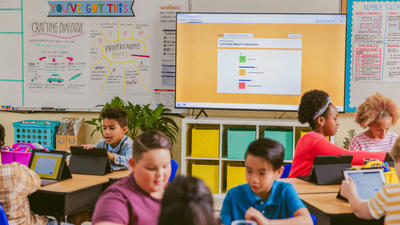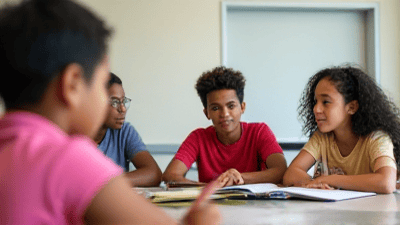
In today's educational landscape, inclusion has become a cornerstone of teaching methodologies. Inclusive classrooms, where diverse learners receive equitable opportunities to learn, grow, and succeed, reflect the rich tapestry of backgrounds, abilities, and experiences among students.
Understanding Inclusive Education
Inclusive education goes beyond simply placing students with disabilities in general education classrooms. It involves a commitment to providing all students with access to high-quality educational experiences tailored to their individual needs. Recognizing that every student brings unique strengths and challenges, inclusive education promotes mutual respect and empathy among peers while fostering a sense of belonging.
Diversity in the classroom can stem from various factors, including disabilities, language barriers, cultural backgrounds, and different learning styles. As educators, embracing this diversity not only benefits individual students but also enriches the learning environment for everyone involved.
The Importance of Inclusive Classrooms
-
Equitable Opportunities for All: Inclusive classrooms ensure that every learner has access to the same resources and opportunities, fostering a sense of equity.
-
Enhanced Peer Relationships: By learning together, students develop friendships and understanding across differences, creating a supportive community.
-
Improved Academic Outcomes: Research indicates that inclusive education positively impacts academic performance for both students with and without disabilities.
-
Social Skills Development: Diverse classrooms promote social interactions that teach essential skills such as collaboration, empathy, and respect.
-
Preparation for Real-World Diversity: Students who learn in inclusive environments are better prepared to navigate and contribute to a world that values diversity.
Strategies for Supporting Diverse Learners
1. Differentiated Instruction
Differentiated instruction is a crucial strategy for meeting the diverse needs of learners in an inclusive classroom. It involves tailoring teaching methods, materials, and assessments to accommodate varying skill levels, interests, and learning preferences. Here are several approaches to consider:
-
Flexible Grouping: Regularly change student groups based on their needs, allowing them to work with peers who can support their learning.
-
Varied Teaching Methods: Incorporate different instructional strategies, such as direct instruction, cooperative learning, and hands-on activities, to cater to various learning styles.
-
Adjusting Content and Process: Modify the content being taught and the methods used to deliver that content to ensure that all students can engage and comprehend.
2. Universal Design for Learning (UDL)
Universal Design for Learning is a framework that emphasizes creating inclusive learning environments by proactively designing lessons and materials that accommodate all learners. UDL principles revolve around three main principles: engagement, representation, and action and expression.
-
Engagement: Provide multiple ways for learners to engage with the content. This can include using real-world examples, offering choices in projects, and incorporating technology.
-
Representation: Present information in multiple formats, such as visual, auditory, and kinesthetic, to ensure that all students have access to the material.
-
Action and Expression: Allow students various ways to demonstrate their understanding, whether through presentations, written assignments, or creative projects.
3. Collaborative Learning
Collaborative learning enhances social interaction and allows students to learn from one another. Implementing cooperative learning strategies can foster an inclusive classroom environment where diverse learners feel valued and engaged.
-
Group Projects: Organize students into small, diverse groups where they can collaborate on projects, sharing their strengths and perspectives.
-
Peer Tutoring: Pair students with different skill levels, enabling them to support one another in their learning journeys.
-
Learning Stations: Create learning stations with different activities that cater to various skills and interests, encouraging students to work both independently and together.
4. Culturally Responsive Teaching
Culturally responsive teaching recognizes and values the diverse cultures represented in the classroom. By incorporating students' cultural backgrounds into the curriculum, educators can enhance engagement and motivation.
-
Inclusive Curriculum: Integrate literature, histories, and perspectives from various cultures into lesson plans, ensuring all students see themselves represented.
-
Culturally Relevant Examples: Use familiar examples from students' own lives to illustrate concepts, making learning more relatable.
-
Celebrate Diversity: Incorporate cultural celebrations, discussions, and activities to honor and learn from the diversity within the classroom.

5. Sensory-Friendly and Flexible Learning Environments
Creating a sensory-friendly classroom is essential for supporting diverse learners, particularly those with sensory sensitivities or other special needs. A flexible learning environment can help students feel comfortable and engaged.
-
Comfortable Space: Designate spaces within the classroom for quiet reflection or sensory breaks, allowing students to recharge.
-
Varied Seating Options: Provide different seating arrangements and options, such as bean bags, floor cushions, or standing desks, to accommodate individual preferences.
-
Visual Supports: Use visual schedules, charts, and graphics to help students navigate routines and understand expectations.
6. Professional Development and Collaboration
For inclusive classrooms to thrive, ongoing professional development for educators is crucial. Teachers must be equipped with the skills and knowledge necessary to support diverse learners effectively.
-
Collaborative Teams: Foster collaboration among educators, special education staff, and support personnel to discuss strategies, share insights, and address challenges collectively.
-
Continuous Learning: Encourage educators to participate in workshops, training sessions, and conferences focused on inclusive education practices.
-
Mentorship Programs: Pair novice teachers with experienced mentors who can provide guidance, resources, and support in managing inclusive classrooms.
7. Family and Community Involvement
Engaging families and the community in the educational process is vital for supporting diverse learners. Building strong connections between home and school fosters a sense of partnership and shared responsibility.
-
Open Communication: Maintain regular communication with families, sharing progress and seeking input on their child’s learning needs and preferences.
-
Family Engagement Events: Organize workshops, informational sessions, or family nights to foster collaboration and understanding among families and educators.
-
Community Resources: Leverage community organizations, resources, and partnerships to provide additional support and opportunities for all learners.
8. Individualized Education Plans (IEPs) and Accommodations
For students with special needs, individualized education plans (IEPs) are essential tools for ensuring their specific requirements are met. Creating and implementing IEPs involves collaboration among educators, specialists, and families.
-
Goal Setting: Work together to set realistic and achievable goals based on each student's strengths and needs.
-
Accommodations: Provide necessary accommodations, such as extended time on tests, modified assignments, and assistive technology, to support students in achieving their goals.
-
Regular Progress Monitoring: Conduct regular assessments to monitor progress and adjust instructional strategies as needed.
9. Promoting a Positive Classroom Culture
Creating a positive classroom culture is fundamental for fostering an inclusive environment where all students feel safe, valued, and respected.
-
Establish Clear Expectations: Set ground rules for behavior and interactions, ensuring that students understand the importance of respect and empathy.
-
Celebrate Achievements: Recognize and celebrate individual and group achievements, promoting a sense of community and belonging.
-
Encourage Self-Advocacy: Teach students to communicate their needs and preferences, empowering them to take an active role in their learning.
Conclusion
Inclusive classrooms have the potential to transform the educational experience for diverse learners, creating an environment where equity, respect, and understanding flourish. By employing a range of effective strategies, educators can support all students in reaching their full potential. As we embrace inclusive education, we not only uplift individual learners but also enrich the educational community as a whole, preparing all students to thrive in an increasingly diverse world.



